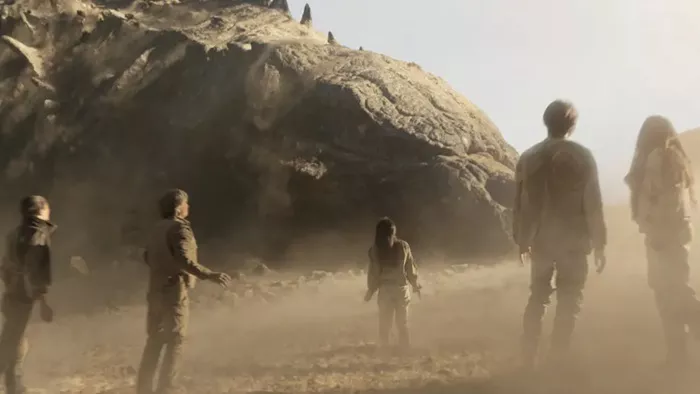VFX supervisor Sean Konrad was tasked with bringing some iconic titans back to life for the eight-part Apple TV+ series “Monarch: Legacy of Monsters. These include Kong: Skull Island’s Mother Longlegs and Godzilla, as well as some new monsters, including a crab-inspired titan and a star-mole beast.
Showrunner and co-creator Chris Black had always wanted to open the series on Skull Island to give viewers a sense of familiarity without having to re-watch the previous films. In the opening episode, Bill Randa (John Goodman) is chased through a bamboo forest that opens onto a rocky peninsula before Mother Longlegs appears. Moments later, a giant rock crab creature known as Mantleclaw emerges from the ground and a battle begins between the two monsters. For Black and Konrad, this was a way to pay homage to the lore of the MonsterVerse and allowed them to draw from the Hawaiian location.
As for the design, Konrad revealed that Mantleclaw was inspired by another creature from the MonsterVerse.
“It feels like an evolutionary shift of a creature, but we modified it to fit the terrain,” Konrad explained. “Its body is almost like volcanic rock.”
To achieve this, there was a mixture of real rock and CG. “We shot real plates for the background and tried to get as many real pieces as possible,” Konrad said. “This beautiful volcanic rock peninsula isn’t next to a bamboo forest, so we put a little bit of a bamboo forest behind them whenever we look in the opposite direction.”
They also had to deal with the constantly changing weather as they “tried to look at the rocky landscape through a drone”. While they were working on the crab vs. spider fight, they also had to work on invisible effects and clean wires out of the background. “That scene was probably 60 shots and we had 18 weeks to work on it.
Another new titan, the Frost Vark, appears in Episode 3 and is a mole-like creature inspired by the star-nosed mole. Executive Producer Tory Tunnell explained: “The concept for the Frost Vark began with a series of brainstorming sessions, born out of research into real and lesser known creatures on our planet for inspiration. We grimaced and squealed as we looked at a number of horrific and bizarre insects, reptiles and more that felt more like the brainchild of a twisted artist than Mother Nature.
Konrad revealed another detail about how the brainstorming session went one step further: Co-creator Matt Fraction’s son was given the task of researching strange animals, and he had to write a 250-word summary of the monster and give it back to Matt. Fraction’s son wasn’t just rewarded with an allowance, he became the mastermind behind the lore’s newest titan – and a hideous-looking one at that.
The VFX team adapted his physiology to the monster’s icy glacier home. Tunnell explains, “By increasing his size exponentially, we came up with a new destructive force that was unique to this monster in our cannon – where our monster sucks the heat out of the victim, whether it be a fire or a human pulse, leaving his subject completely frozen.
The latest episode in the series sees the return of Godzilla and answers many theories as to his whereabouts. Last seen swimming out of San Francisco Bay in 2014, many wondered where he had gone. But it turned out that Hiroshi Randa had activated a device that emitted gamma signals, and Godzilla emerged from the ground in the Algiers Dessert in 2015.
Konrad says: “In general, we tried to tie his design and animation to the look established in the feature films, albeit with some extra wetness or dust when it was appropriate for the scene. Godzilla has two looks that follow his looks from the feature films. In our 1950s timeline, his dorsal fins are spikier, and after the damage he suffered in the 2014 film, his fins grew back with more curvature, so we see that in our ‘modern’ 2015 timeline.”
Konrad explains that, stylistically, Episode 6 grounds the view of Godzilla as much as possible in a subjective human perspective. He says: “Our cameras rarely go above ground level, and when we did an objective shot, we tried to earn it by making his movements something that a drone or a helicopter could do, and only after we had already established the size from the human scale”.
“We want the audience to experience the immensity from our character’s point of view, to keep them part of the action.”

























